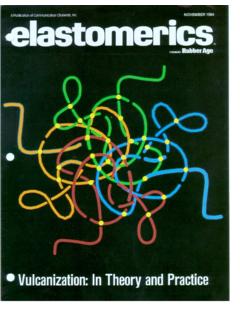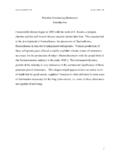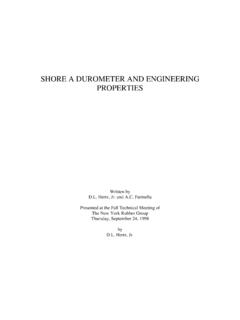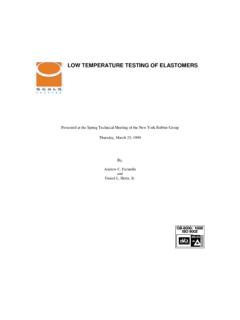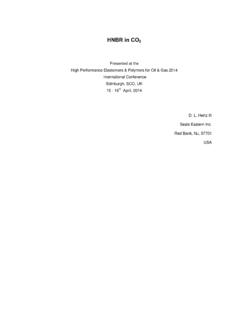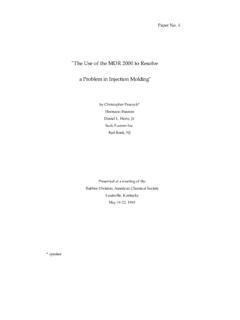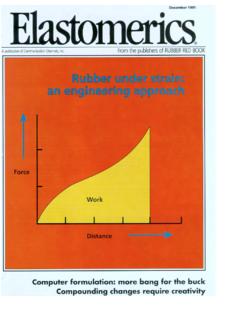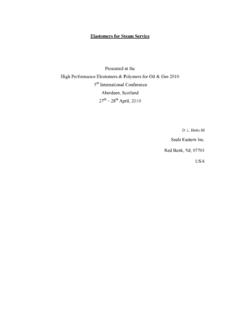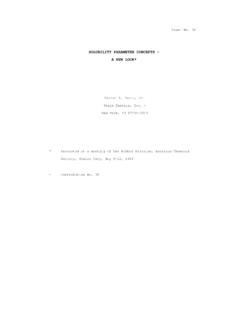Transcription of Paper No. 58 Nitrile Rubber - Past, Present & …
1 Paper No. 58 & quot ; Nitrile Rubber - past , Present & future & quot ; by D. L. Hertz, Jr.* and Hermann Bussem Seals Eastern, Inc., Box 519, Red Bank, NJ 07701 and T. W. Ray Halliburton Energy Services, Inc., Box 819052, Dallas, Texas 75381-9052 Presented at a meeting of the Rubber Division, American Chemical Society Pittsburgh, Pennsylvania October 11-14, 1994 *speaker ABSTRACT Nitrile Rubber - past , Present & future Nitrite Rubber (NBR) has been the work-horse elastomer in oil & gas production for the past fifty years. As wells began producing increasing amounts of hydrogen sulfide (H2S) through stimulation or reservoir conditions coupled with higher production temperatures, sporadic seal and packer failures have been encountered. future applications of nitrite Rubber in higher temperature production should only be considered after reviewing the range of chemical attacks capable by the well fluids, completion fluids and stimulation fluids this Paper briefly outlines.
2 INTRODUCTION For the past fifty years nitrite Rubber (NBR) has been the logical elastomer of choice for service in the oil and gas industry. As wells became deeper, production temperatures logically increased. Occasional field failures would surface due to excessive elastomer hardening which in turn could result in leaks, inoperative controls and nonretrievable & quot ;retrievable packers& quot ;. Working jointly with Halliburton Engineering Services (formerly Otis Engineering), numerous failed field sample components were analyzed by Seals Eastern. Additionally, several in-house test programs were initiated at Seals Eastern using typical fluids the production elastomeric components might routinely be subjected to. These media included inhibitors, acidizing mixtures, sea water and completion fluids. EXPERIMENTAL Nitrite Rubber (NBR) is the work horse oil-resistant elastomer of choice for typical sealing applications. A copolymer of butadiene (BR) and acrylonitrile (ACN), is produced by emulsion polymerization with the specifications defined by ACN level and Mooney viscosity.
3 The briefest review of these elastomers will point out that the structure (molecular architecture) is relatively complex. The butadiene monomer copolymerizes into three distinct structures : trans, cis and 1,2-. The trans configuration dominates ( 78%) in a typical nitrite, inevitably there will be blocks of these units. 3 A 100% trans butadiene polymer would be a plastic (like gutta-percha in polyisoprene), hence these blocks are sensitive to heat in terms of shear thinning. The cis configuration, ( 12%), serves to break-up substantial crystallinity since it enters in a statistical pattern. The 1,2- sites ( 10%), are free vinyl groups typically causing branching and often gel (insoluble polymer). The acrylonitrile (ACN) groups are inserted in a statistical pattern ranging from head-tail, head-head and tail-tail. Nomenclature Butadiene. - (1,3-butadiene), a hydrocarbon gas is produced by numerous processes, ex: catalytic dehydrogenation of butene or butane-butene mixtures.
4 It polymerizes readily to form either a polymer or copolymer and in terms of chemical reactivity it is a very stable, nonpolar hydrocarbon due to the symmetry of its' molecular structure consisting of carbon and hydrogen. Acrylonitrile .- (2-propenenitrile), a liquid, is produced predominantly by the ammoxidation of propylene: We are specifically detailing this chemistry as it points out the potential of driving a reverse reaction or what is commonly referred to as hydrolysis (cleavage by water). Acrylonitrile is a very polar molecule due to the lack of symmetry of the triplebonded nitrogen coupled with the nitrogens' lone-pair electron effect. The lone pair effect plus a large dipole moment created by the nitrogen developes a very strong H - bonding potential (witness NBR swelling in methanol-gasoline combinations). 4 Monomeric Stabilities. -The butadiene monomer as noted consists of a carbon backbone and hydrogen atoms.
5 The hydrogen - carbon bond energy is 411kJ mol-1, there are no lone pair electron considerations for the M1 to M4 elements so we do not experience possible reduced bond energy consideration. The acrylonitrile (ACN) monomer is a different story. Considering the cyano (CN) group specifically, there is a lone pair effect on the M5 (nitrogen) to M8 elements which tend to weaken bond energies. Consider the varying bond strengths of possible carbon-nitrogen combinations: C N 891 kJ mol-1 C= N 615 kJ mol-1 C - N 305 kJ mol-1 it is apparent that the breaking of one or more of the carbon-nitrogen triple bonds can lead to a host of potential interactions. Chemistry. -The fundamental issue is that any physical change in the elastomer (other than plasticizer loss) is due to a chemical reaction. In most organic reactions, one or more covalent bonds are broken.
6 This normally causes a conversion of a functional group in the molecule from one category to a higher one. In the breaking of a covalent bond, electrons are never unpaired (not for long anyway as we will note shortly). All chemical reactions can be simplified to accomplish three (3) basic mechanisms and six types of reactions. Mechanisms: 1. Heterolytic cleavage. When a single bond (two electrons) breaks leaving both the electrons on one of the fragments. In the case of carbon-carbon bonds, we will consider the carbon atom, the substrate and the attacking reactant, the reagent. 5 A reagent generally brings a pair of electrons (donor) or takes a pair of electrons (acceptor). A Donor is called a nucleophile (Lewis base) and the reaction - nucleophilic. An Acceptor is called an electrophile (Lewis acid) and the reaction - electrophilic. 2. Homolytic cleavage (free-radical mechanism) is the breakage of a single bond (two electrons) leaving one of the electrons on each of the fragments.
7 3. Pericyclic reactions. The third reaction mechanism is not common in this discussion. Tyres of 1. Substitution 2. Additions to multiple bonds 3. elimination 4. Rearrangement 5. Oxidation and reduction 6. Combinations of above Knowing the elastomer chemical structure and reviewing a first year organic chemistry textbook will answer most questions of where these reactions might occur. Chemical reactions-butadiene, cis, trans we consider the diene double-bond site as the weakest link. This is a problem for NBR components exposed to UV (sunlight, fluorescent lights-unshielded) ozone and oxidative environments. These conditions are not an issue in the down-hole environment. Sulfur (elemental) and hydrogen sulfide (H2S) might erroneously be considered potential crosslinkers in the production environment but this is not true. Sulfur might cause some surface hardening but it might be somewhat ingenuous to assume the atomic sulfur to be sufficiently mobile to permeate the elastomer.
8 6 H2S is also a very stable gas, a saturated solution of H2S and water creates an acidic environment with a pH of 4. H2S (a Bronsted acid) does have the potential of adding to the double bond but only at higher temperatures in the presence of strong Lewis acid. Strong Lewis acids are not typical in the production environment. 1, thermally crosslink thru any of the CH2 groups in a reductive environment causing excessive hardening, however temperatures have to be in excess of 200 C. Chemical back to the acrylonitrile production reaction (1) it is apparent that this is a monomer not only vulnerable to hydrolysis but also reduction. the nitrite group catalyzed by an acid (Bronsted) or base typically follows the following path: -CN (cyano group) -COOR (ester group) -COOH (carboxylic acid group) C=O (carbonyl group) However, the reaction path listed is not rigid. Nitrite conversion direct to carboxylic groups or amides is possible.
9 Additional possible routes are carboxylic groups yielding esters initiated by ROH presence. 7 the nitrite group catalyzed by a Lewis acid with a source of hydrogen (H2O) yields a primary (1 ) amine (-CH2NH2). Physical basis of reactions are generally temperature dependent with the reaction proceeding more rapidly as the temperature increases. Considering now that all of the precursors of nitrite Rubber were gases (butadiene, propylene and ammonia) our elastomer can be defined as a supercondensed gas. The most stable thermodynamic state (highest entropy) is a gas. An elastomer is a solid, hence, the eventual progression to thermodynamic stability is the procession from a solid, to a liquid, ultimately - a gas. Since the elastomer does not spontaneously move from the solid state to a gaseous state there must be a barrier. This barrier (or intermediate state) is called the transition state. The energy difference between the reactant and the transition state is called the activation energy, Ea , (Fig.)
10 1). Heat increases the mobile energy of atoms and only molecules with energy comparable to the transition state can get over the energy barrier to rearrange. Not every molecule in the transition state will rearrange due to statistical considerations and collisions with other molecules which often deactivate the active molecule. Since we have a random dissociation situation there is time dependency. We should consider the elastomer under any condition as being in a metastable state (an excited stationary energy state whose lifetime is unusually long). reaction rates are increased by substances called catalysts. A catalyst speeds up a reaction by providing an alternative pathway from the reactants to products. The new pathway has a rate - determining step with a lower activation energy E, than the orginal pathway (Fig. 2). One of the earliest catalyst combinations was hydrochloric acid (HCl) and iron. 8 Catalysis can be initiated by acids, bases, metal ions, phase transfer agents, zeolites, enzymes, etc.

